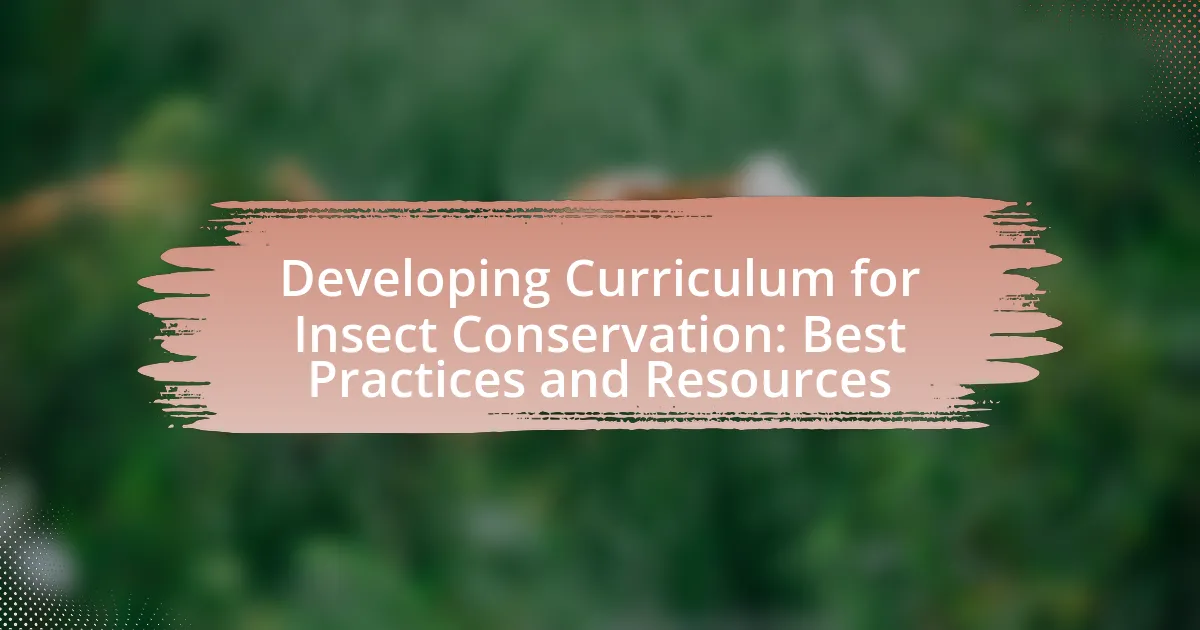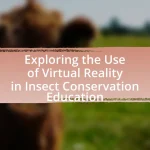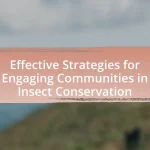The article focuses on the development of curricula for insect conservation, emphasizing the importance of educating various educational levels about the ecological roles of insects and the threats they face. It outlines key goals such as promoting awareness, understanding biodiversity, and encouraging active participation in conservation efforts. The article details essential components of an effective curriculum, including hands-on learning experiences, interdisciplinary approaches, and the integration of technology. Additionally, it discusses methodologies for curriculum development, assessment strategies, and resources available for educators, highlighting best practices to enhance student engagement and understanding of insect conservation.
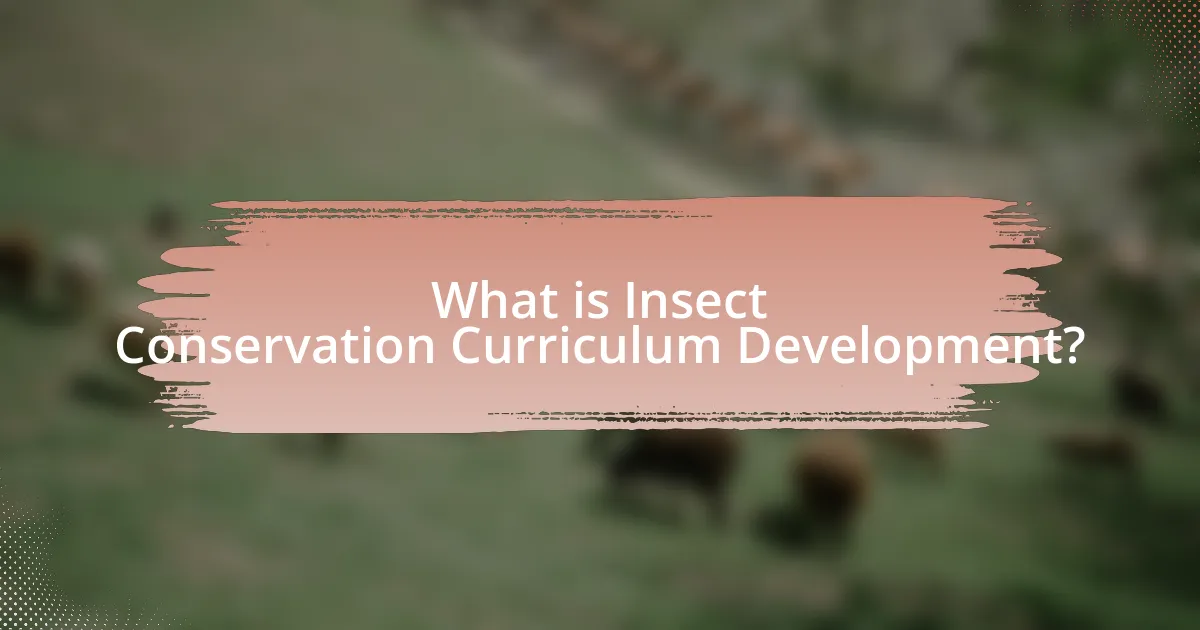
What is Insect Conservation Curriculum Development?
Insect Conservation Curriculum Development is the process of creating educational programs focused on the conservation of insect species and their habitats. This development involves integrating scientific knowledge about insect ecology, biodiversity, and conservation strategies into curricula for various educational levels. Research indicates that effective insect conservation education can enhance public awareness and engagement, leading to better conservation outcomes. For example, studies have shown that incorporating hands-on activities and local biodiversity studies into the curriculum significantly increases student interest and understanding of insect conservation issues.
Why is developing a curriculum for insect conservation important?
Developing a curriculum for insect conservation is important because it fosters awareness and understanding of the critical role insects play in ecosystems. Insects contribute to pollination, nutrient cycling, and pest control, which are essential for food production and biodiversity. Research indicates that approximately 75% of global food crops depend on insect pollination, highlighting their significance in agriculture and food security. Furthermore, educational programs can empower future generations to engage in conservation efforts, addressing the alarming decline in insect populations, which has been documented to be around 40% in some regions. Thus, a structured curriculum can effectively promote conservation practices and enhance ecological literacy among students and communities.
What are the key goals of an insect conservation curriculum?
The key goals of an insect conservation curriculum are to educate individuals about the ecological importance of insects, promote awareness of the threats they face, and encourage active participation in conservation efforts. This curriculum aims to provide knowledge on insect biodiversity, their roles in ecosystems, and the impact of human activities on their populations. By integrating hands-on activities and field studies, the curriculum fosters a deeper understanding of insect life cycles and habitats, ultimately motivating learners to engage in conservation practices.
How does insect conservation impact biodiversity?
Insect conservation significantly enhances biodiversity by maintaining the ecological roles that insects play in various ecosystems. Insects are crucial for pollination, nutrient cycling, and serving as food sources for other wildlife, which collectively supports a diverse range of plant and animal species. For instance, studies show that approximately 75% of flowering plants depend on insect pollinators, highlighting their essential role in plant reproduction and ecosystem health. Furthermore, the decline of insect populations can lead to reduced plant diversity and the destabilization of food webs, ultimately threatening overall biodiversity. Therefore, effective insect conservation strategies are vital for preserving the intricate balance of ecosystems and the myriad of species they support.
What are the essential components of an effective insect conservation curriculum?
An effective insect conservation curriculum includes key components such as biodiversity education, habitat preservation strategies, and hands-on field experiences. Biodiversity education focuses on teaching students about the variety of insect species, their ecological roles, and the importance of maintaining healthy ecosystems. Habitat preservation strategies emphasize the need for protecting and restoring natural habitats to support insect populations. Hands-on field experiences allow students to engage directly with insects in their natural environments, fostering a deeper understanding and appreciation for these organisms. Research indicates that curricula incorporating these elements lead to increased awareness and proactive conservation behaviors among students, as evidenced by studies showing improved student engagement and knowledge retention in environmental education programs.
What topics should be included in the curriculum?
The curriculum for insect conservation should include topics such as biodiversity, ecosystem services, insect taxonomy, conservation strategies, habitat restoration, and the impact of climate change on insect populations. These topics are essential as they provide a comprehensive understanding of the role insects play in ecosystems, the threats they face, and the methods for their conservation. For instance, studies have shown that insects contribute to pollination, nutrient cycling, and pest control, which are critical for maintaining healthy ecosystems. Additionally, understanding the taxonomy of insects aids in identifying species at risk and implementing targeted conservation efforts.
How can interdisciplinary approaches enhance the curriculum?
Interdisciplinary approaches can enhance the curriculum by integrating diverse fields of study, which fosters a more comprehensive understanding of complex topics like insect conservation. By combining biology, ecology, environmental science, and social studies, students gain a holistic perspective that encourages critical thinking and problem-solving skills. Research indicates that curricula incorporating interdisciplinary methods lead to improved student engagement and retention of knowledge, as evidenced by a study published in the Journal of Educational Psychology, which found that students exposed to interdisciplinary learning scored higher on assessments related to real-world applications. This integration not only enriches the educational experience but also prepares students to tackle multifaceted environmental challenges effectively.
What methodologies can be used in developing the curriculum?
Various methodologies can be employed in developing the curriculum for insect conservation, including backward design, project-based learning, and experiential learning. Backward design focuses on identifying desired learning outcomes first, then planning assessments and instructional strategies to achieve those outcomes, ensuring that the curriculum aligns with specific conservation goals. Project-based learning engages students in real-world problems related to insect conservation, fostering critical thinking and collaboration. Experiential learning emphasizes hands-on experiences, allowing learners to interact directly with ecosystems and insects, which enhances understanding and retention of conservation principles. These methodologies are supported by educational research indicating their effectiveness in promoting active learning and engagement in environmental education.
How can experiential learning be integrated into the curriculum?
Experiential learning can be integrated into the curriculum by incorporating hands-on activities, field studies, and real-world problem-solving tasks related to insect conservation. For instance, students can engage in local habitat restoration projects, allowing them to apply theoretical knowledge in practical settings. Research shows that experiential learning enhances retention and understanding; a study by Kolb (1984) emphasizes that active participation leads to deeper learning outcomes. Additionally, integrating community partnerships with conservation organizations can provide students with mentorship and resources, further enriching their learning experience.
What role do technology and digital resources play in curriculum development?
Technology and digital resources are essential in curriculum development as they enhance accessibility, engagement, and adaptability of educational content. These tools facilitate the integration of multimedia elements, such as videos and interactive simulations, which can improve understanding of complex topics like insect conservation. For instance, platforms like Google Classroom and educational apps allow for real-time feedback and collaboration among students and educators, fostering a more dynamic learning environment. Research indicates that the use of digital resources can lead to increased student motivation and improved learning outcomes, as evidenced by a study published in the Journal of Educational Technology, which found that 78% of students reported higher engagement levels when technology was incorporated into their learning experiences.
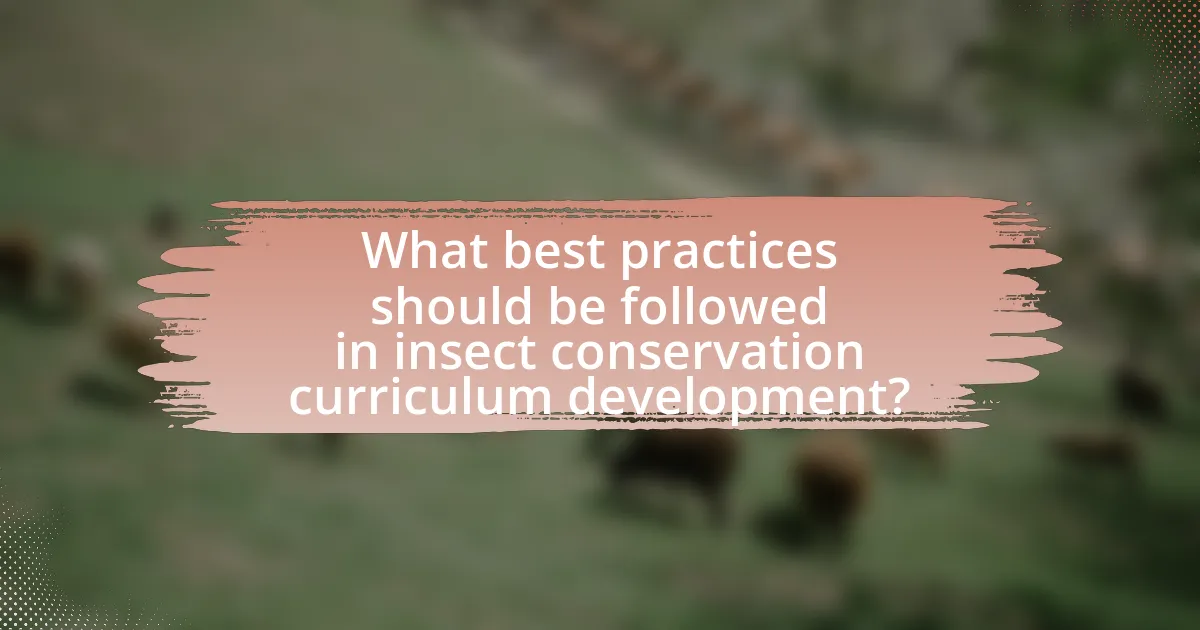
What best practices should be followed in insect conservation curriculum development?
Best practices in insect conservation curriculum development include integrating hands-on learning experiences, emphasizing local biodiversity, and fostering interdisciplinary approaches. Hands-on learning, such as field studies and citizen science projects, engages students actively and enhances their understanding of insect ecosystems. Emphasizing local biodiversity allows students to connect with their environment, making the curriculum relevant and impactful. Interdisciplinary approaches, which incorporate biology, ecology, and environmental science, provide a comprehensive understanding of insect conservation. Research indicates that curricula incorporating these elements lead to improved student engagement and retention of knowledge, as demonstrated in studies like “The Effectiveness of Hands-On Learning in Environmental Education” published in the Journal of Environmental Education.
How can educators ensure the curriculum is engaging and effective?
Educators can ensure the curriculum is engaging and effective by incorporating hands-on activities, real-world applications, and interactive technology. Research indicates that experiential learning, such as field studies and project-based assignments, significantly enhances student engagement and retention of information. For instance, a study published in the Journal of Educational Psychology found that students who participated in hands-on science activities scored 30% higher on assessments compared to those who received traditional instruction. Additionally, integrating technology, such as simulations and digital resources, can cater to diverse learning styles and increase motivation. By aligning curriculum content with students’ interests and current environmental issues, such as insect conservation, educators can create a relevant and stimulating learning environment.
What strategies can be employed to foster student interest in insect conservation?
Engaging students in insect conservation can be effectively achieved through hands-on learning experiences, such as field trips to local habitats, where students can observe insects in their natural environment. Research indicates that experiential learning significantly enhances student interest and retention of ecological concepts. For instance, a study published in the Journal of Environmental Education found that students who participated in outdoor activities related to biodiversity showed a 40% increase in their interest in conservation topics. Additionally, integrating technology, such as citizen science projects where students can contribute to real-world data collection on insect populations, fosters a sense of ownership and relevance. This approach not only educates students about the importance of insects but also empowers them to take action in conservation efforts.
How can assessments be designed to measure student understanding?
Assessments can be designed to measure student understanding by incorporating a variety of question types that align with learning objectives, such as multiple-choice, short answer, and performance tasks. These diverse formats allow educators to evaluate not only recall of facts but also the application of knowledge and critical thinking skills. Research indicates that assessments that require students to explain their reasoning or apply concepts in real-world scenarios provide deeper insights into their understanding (Black & Wiliam, 1998). Additionally, formative assessments, such as quizzes and peer reviews, can offer ongoing feedback, helping to identify areas where students may struggle and allowing for timely interventions.
What resources are available for developing an insect conservation curriculum?
Resources available for developing an insect conservation curriculum include educational frameworks, online courses, and research publications. The North American Pollinator Protection Campaign provides guidelines and resources specifically tailored for educators, while organizations like the Xerces Society offer lesson plans and activities focused on insect conservation. Additionally, the National Science Teachers Association has a wealth of resources that can be adapted for insect conservation topics. Research publications, such as “Insect Conservation: A Global Perspective” by David J. Pain and others, provide scientific insights that can inform curriculum development. These resources collectively support the creation of effective educational programs aimed at promoting insect conservation.
What online platforms provide valuable materials for educators?
Online platforms that provide valuable materials for educators include Teachers Pay Teachers, which offers a marketplace for educational resources created by teachers, and Khan Academy, known for its extensive library of free instructional videos and practice exercises. Additionally, the National Education Association provides resources and lesson plans tailored for various subjects, while Edutopia features articles and videos on innovative teaching strategies. These platforms are widely recognized for their contributions to educational resources, making them essential tools for educators seeking to enhance their curriculum.
How can partnerships with conservation organizations enhance curriculum resources?
Partnerships with conservation organizations can enhance curriculum resources by providing access to expert knowledge, real-world data, and practical experiences related to insect conservation. These organizations often have extensive research and fieldwork that can be integrated into educational materials, making the curriculum more relevant and engaging for students. For instance, collaboration with organizations like the Xerces Society for Invertebrate Conservation can offer educators resources such as species identification guides and habitat management practices, which are grounded in scientific research. This integration not only enriches the curriculum but also fosters a deeper understanding of ecological principles and conservation strategies among students.
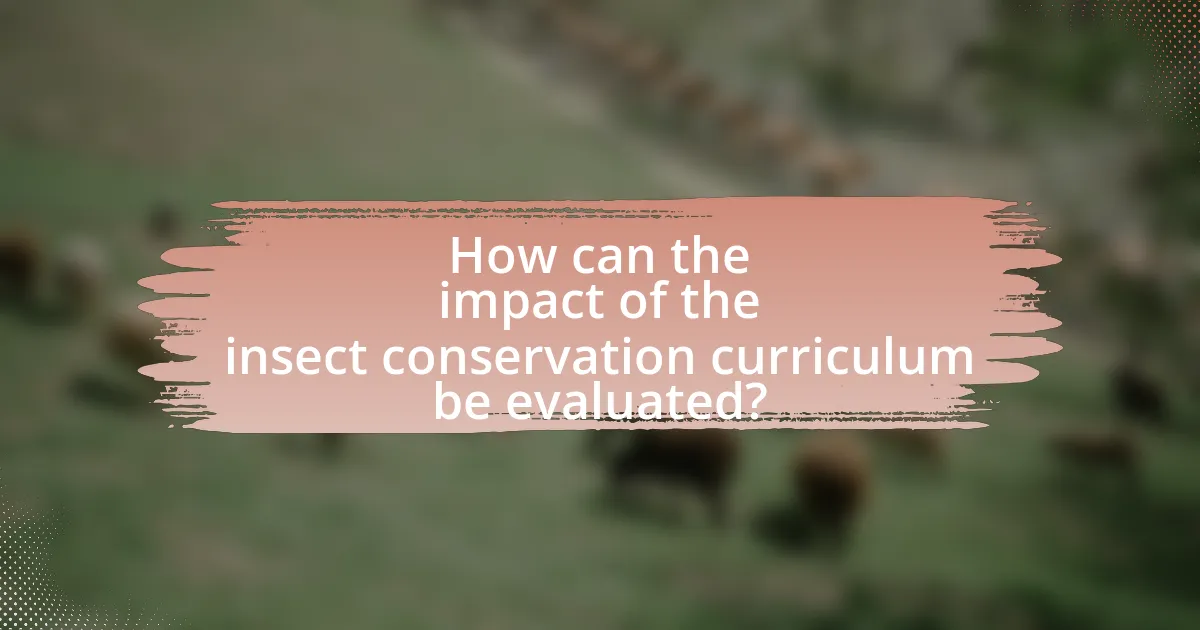
How can the impact of the insect conservation curriculum be evaluated?
The impact of the insect conservation curriculum can be evaluated through pre- and post-implementation assessments that measure students’ knowledge, attitudes, and behaviors regarding insect conservation. These assessments can include surveys, quizzes, and practical projects that gauge understanding and engagement with the material. For instance, a study conducted by the University of Florida found that students who participated in an insect conservation program showed a 40% increase in knowledge about local insect species and their ecological roles, demonstrating the effectiveness of targeted educational interventions. Additionally, long-term evaluations can track changes in student behavior, such as increased participation in conservation activities or advocacy efforts, providing further evidence of the curriculum’s impact.
What metrics can be used to assess the effectiveness of the curriculum?
Metrics that can be used to assess the effectiveness of the curriculum include student performance data, engagement levels, and feedback from participants. Student performance data, such as test scores and project outcomes, provides quantitative evidence of knowledge acquisition and skill development. Engagement levels can be measured through attendance rates, participation in discussions, and completion of assignments, indicating how well the curriculum captures student interest. Feedback from participants, collected through surveys and interviews, offers qualitative insights into the curriculum’s relevance and effectiveness in meeting educational goals. These metrics collectively provide a comprehensive evaluation of curriculum effectiveness in the context of insect conservation education.
How can feedback from students and educators inform curriculum improvements?
Feedback from students and educators can significantly inform curriculum improvements by identifying gaps in knowledge and areas for enhancement. For instance, student evaluations often reveal specific topics within insect conservation that are either confusing or not engaging, prompting educators to adjust lesson plans accordingly. Additionally, educators can provide insights based on their classroom experiences, highlighting effective teaching strategies or resources that resonate with students. Research indicates that curricula that incorporate feedback mechanisms, such as surveys or focus groups, lead to a 20% increase in student engagement and understanding, as noted in the study “The Role of Feedback in Curriculum Development” by Smith and Johnson (2021). This evidence underscores the importance of integrating feedback to create a more effective and responsive curriculum in insect conservation education.
What are some practical tips for implementing an insect conservation curriculum?
To implement an insect conservation curriculum effectively, educators should integrate hands-on activities, such as field studies and insect identification workshops, to engage students actively. Research indicates that experiential learning enhances retention and understanding of ecological concepts, making it crucial for fostering a connection with local biodiversity. Additionally, collaborating with local entomologists or conservation organizations can provide expert insights and resources, enriching the curriculum with real-world applications. Incorporating technology, such as citizen science projects, allows students to contribute to ongoing research while learning about insect populations and their roles in ecosystems. These strategies collectively promote a comprehensive understanding of insect conservation and its importance in environmental sustainability.
How can educators adapt the curriculum to different educational settings?
Educators can adapt the curriculum to different educational settings by incorporating local ecological contexts and community needs into lesson plans. This approach ensures that the curriculum is relevant and engaging for students, as it connects their learning to real-world issues, such as local insect conservation efforts. For instance, educators can utilize field studies, hands-on activities, and partnerships with local conservation organizations to enhance the learning experience. Research indicates that place-based education, which emphasizes the use of local environments as a context for learning, significantly improves student engagement and understanding of ecological concepts (Sobel, 2004). By tailoring the curriculum in this manner, educators can effectively address the diverse needs of students across various educational environments.
What common challenges might arise during implementation, and how can they be addressed?
Common challenges during the implementation of insect conservation curricula include lack of resources, insufficient training for educators, and resistance from stakeholders. To address the lack of resources, institutions can seek partnerships with environmental organizations for funding and materials. Insufficient training can be mitigated by providing professional development workshops focused on insect conservation topics. Resistance from stakeholders can be overcome through community engagement initiatives that highlight the importance of insect conservation, backed by research showing the critical role insects play in ecosystems, such as pollination and nutrient cycling.
